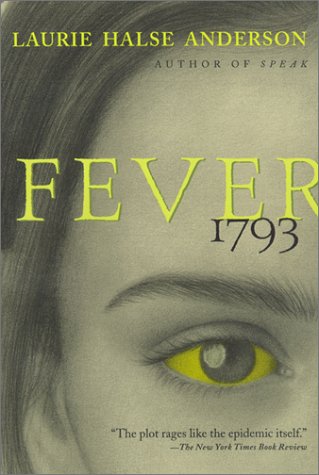
Kay, Verla. (2003)Orphan Train. Illustrated by Ken Stark. Putnam Juvenile.
Visit
THIS SITE for more information about the author Verla Kay

Anderson, Laurie. (2002)
Fever 1793. Simon & Schuster Publishing
From Publishers WeeklyThe opening scene of Anderson's ambitious novel about the yellow fever epidemic that ravaged Philadelphia in the late 18th century shows a hint of the gallows humor and insight of her previous novel, Speak. Sixteen-year-old Matilda "Mattie" Cook awakens in the sweltering summer heat on August 16th, 1793, to her mother's command to rouse and with a mosquito buzzing in her ear. She shoos her cat from her mother's favorite quilt and thinks to herself, "I had just saved her precious quilt from disaster, but would she appreciate it? Of course not." Mattie's wit again shines through several chapters later during a visit to her wealthy neighbors' house, the Ogilvies. Having refused to let their serving girl, Eliza, coif her for the occasion, Mattie regrets it as soon as she lays eyes on the Ogilvie sisters, who wear matching bombazine gowns, curly hair piled high on their heads ("I should have let Eliza curl my hair. Dash it all"). But thereafter, Mattie's character development, as well as those of her grandfather and widowed mother, takes a back seat to the historical details of Philadelphia and environs. Extremely well researched, Anderson's novel paints a vivid picture of the seedy waterfront, the devastation the disease wreaks on a once thriving city, and the bitterness of neighbor toward neighbor as those suspected of infection are physically cast aside. However, these larger scale views take precedence over the kind of intimate scenes that Anderson crafted so masterfully in Speak. Scenes of historical significance, such as George Washington returning to Philadelphia, then the nation's capital, to signify the end of the epidemic are delivered with more impact than scenes of great personal significance to Mattie. Ages 10-14. (Sept.) Copyright 2000 Reed Business Information, Inc. --This text refers to the
Hardcover edition.

Prince, April. (2005)
Twenty One Elephants and Still Standing. Illustrated by Francois Roca. Houghton Mifflin.
*Brooklyn Bridge
*Elephants
*Circus
*Bridges
For another splendid version of this tale, check out
Twenty-One Elephants (2004)

Fleming, Candace. (2004)
A Big Cheese for the White House; A True Tale of a Tremendous Cheddar. Illustrated by S.D. Schindler. Farrar, Straus and Giroux.

Innocenti, Roberto (1985). Rose Blanche. Mankato, MN. Creative Education.
Excerpt from
THIS NY Times Review:
ROSE BLANCHE By Christophe Gallaz and Roberto Innocenti. Illustrated by Roberto Innocenti. Translated by Martha Coventry and Richard Graglia. Illustrated. Unpaged. Mankato, Minn.: Creative Education. $14.95. (Ages 8 and up) IT is our duty to tell children some terrible truths. If the telling causes horror and sorrow, these are appropriate emotions for certain recent historical events, and it is necessary for the young to suffer this painful learning if the future is not to repeat the worst mistakes of the past. But we must be careful to do the telling right.

Low, William
Park, Linda Sue. (2003)
A Single Shard. Yearling.
There is a great review of this book
HERE!

Vander Zee, Ruth. (2003)
Erika's Story. Illustrated by Roberto Innocenti. Creative Editions.
From School Library Journal:Grade 3 Up-Vander Zee narrates this true story in the voice of Erika, a woman she encountered in a German village, who, as a blanket-wrapped infant, was thrown from a cattle car bound for a concentration camp in 1944. ("On her way to death, my mother threw me to life.") A German woman risked her own life to raise Erika, who eventually married and had children of her own. ("Today my tree once again has roots.") The spare, eloquent text perfectly complements Innocenti's gray and beige photo-realistic illustrations that show haunting, finely detailed, sterile winter scenes of train cars, tracks, and cold brick-and-stone buildings surrounded by barbed wire. On other pages, a white baby carriage and the small pink bundle catch the eye. Only the contemporary opening scene and the final postwar spread are in full color. Compelling and powerful in its simplicity, Erika's story proves that determination, hope, and goodness can overcome evil. Stars are important to this story. Yellow Stars of David are visible on the people's clothing and the symbol appears on every page, separating Erika's thoughts. She mentions God's biblical promise to Abraham that his people "would be as many as the stars in the heavens," and that "six million of those stars fell between 1933 and 1945." The large die-cut yellow pentagram on the front cover is a jarring exception to the carefully crafted text and illustrations. This poignant story of survival deserves a wide audience.Susan Scheps, Shaker Heights Public Library, OH






